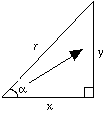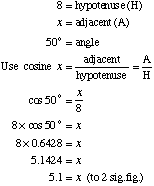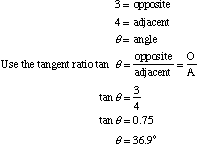 Trigonometry is concerned with the measurement and calculation of the lengths of sides and the sizes of angles of triangles. There are three basic ratios called the sine, the cosine and the tangent of the angle. These are abbreviated to sin, cos and tan.
Trigonometry is concerned with the measurement and calculation of the lengths of sides and the sizes of angles of triangles. There are three basic ratios called the sine, the cosine and the tangent of the angle. These are abbreviated to sin, cos and tan.
Greek letters are often used to stand for angles in triangles.
Right-angled Triangles
|
Given a right-angled triangle with an angle marked a as shown: In the diagram: y is called the opposite side (to the angle α ) x is called the adjacent side (to the angle α) r is called the hypotenuse side Greek letters, such as α are often used in trigonometry. |
 |
There are several methods used for finding angles and sides in right-angled triangles. You may have been taught and use a different one to that shown below. They all produce the same answers if done correctly!
For example, some people call the opposite side, the separated side and the adjacent side, theconnected side.
|
In the triangle shown, how long is: (a) The side opposite to θ ? (b) The side adjacent to θ ? (c) The hypotenuse? |
 |
(a) The opposite side is 5 cm long. (b) The adjacent side is 6 cm long. (c) The hypotenuse is 8 cm long.
|
Trigonometric Ratios
For a right-angled triangle:
|
Sine of angle α = |
|
|
|
Cosine of angle α = |
|
|
|
Tangent of angle α = |
|
TOA |
Circular Functions
Click here for an activity showing the sine as a circular function.
Click here for an activity showing the cosine as a circular function.
Click here for an activity showing the tangent as a circular function.
Finding Ratios
The sine, cosine and tangent ratios are the same for a particular angle regardless of the size of the triangle.
The ratios can be found using a calculator or from trigonometric tables.
Calculators.
Most calculators have trigonometric function keys. These will give the sine, cosine, and tangent of an angle as well as the inverse of these functions. These decimals will be given to a large number of significant figures, which will often need to be rounded off (4 significant figures is usually accurate enough).
e.g To find sine 53° on a typical scientific calculator, press ![]()
![]()
![]()
![]() 0.79863551 which could then be rounded as necessary.
0.79863551 which could then be rounded as necessary.
The other trigonometric buttons are ![]() and
and ![]() .
.
Care must be taken to ensure that the calculator is set to work in values in degrees (DEG), as there are other ways of measuring angles such as radians (RAD) and gradians (GRAD). Use themode button to change these settings.
Tables.
Before the days of calculators, everyone used printed tables giving the trigonometric ratios and these can be used if you do not have a calculator available. These tables give the ratios for angles from 0° to 90° to four or five significant figures, with angles being given to 1 decimal place.
Solution of Right-angled Triangles
The sides and angles of right-angled triangles can be found using the trigonometric ratios. For each problem the information given should be written down and substituted into one of the ratios, which can then be solved as an equation.
Remember to use Pythagoras' Theorem if only sides are involved. The final answer should be rounded off to a similar degree of accuracy to that given to measurements in the question.
|
(a) Find the length of x |
On a calculator the step of writing out cos 50° can be missed out:
|
|
(b) Find angle  |
On a calculator this last step is done as follows:
|


